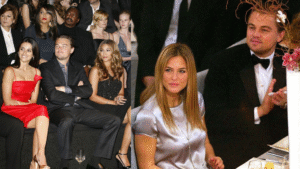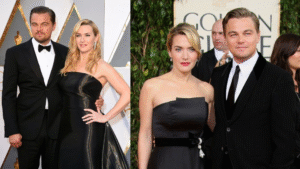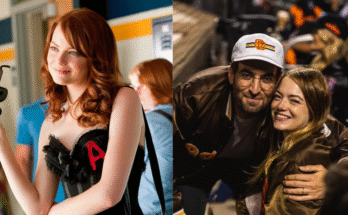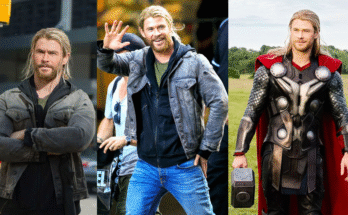The Heart Behind the Intensity: Meet Leonardo DiCaprio
In the glittering world of Hollywood where child actors typically fade into obscurity, one boy defied every expectation. He didn’t just survive childhood stardom—he transformed into one of cinema’s greatest actors, a visionary collaborator, and one of the world’s most influential environmental activists.
Leonardo DiCaprio’s journey isn’t about luck or connections. It’s about relentless commitment to craft, strategic reinvention, and the courage to turn down massive paychecks for artistic integrity.
How a Child Actor Became One of Cinema’s Greatest Talents
The Beginning: Born Into Performance
November 11, 1974 – Leonardo Wilhelm DiCaprio was born in Los Angeles, California, to George DiCaprio, an underground comic book publisher and former actor, and Irmelin Indenbirken, a former legal secretary.
Despite his artistic father, Leonardo’s childhood wasn’t marked by showbiz privilege:
The Reality:
- His father was pursuing unconventional art, not commercial success
- His mother was focused on practicality and education
- They lived in modest circumstances in Los Angeles
- Acting wasn’t pushed on young Leonardo
- He discovered performance organically
The Discovery: Performance as Expression
As a child, Leonardo discovered something magical about inhabiting characters:
The Early Years:
- Started performing in school plays
- Joined a local youth theater group
- Loved the escape and expression of performance
- Found in acting a way to explore different identities
- Realized early that acting wasn’t just entertainment—it was art
The Audition: At age 14, Leonardo auditioned for a television commercial. Instead of a minor gig, it led to something bigger.
The Invisible Years: From Child Actor to Serious Performer (1989-1995)
Television Success: Building Foundation
Leonardo’s early career involved television work:
“Romper Room” (1989) – Early television appearance “Santa Barbara” (1990-1991) – Soap opera role “Growing Pains” (1991-1992) – Guest appearances on popular sitcom “The Outsiders” (1995) – Television movie
The Pattern: Leonardo wasn’t pursuing fame. He was building craft and experience. Each television role taught him something about acting, about character development, about working with professionals.
The Critical Decision: Rejecting Easy Money
By his late teens, Leonardo could have:
- Remained on successful television shows earning steady income
- Pursued teen idol status and commercial success
- Built a comfortable, profitable career on television
Instead, he chose something harder.
He decided to pursue serious film acting—where competition was fiercer, opportunities were less certain, and the path was less defined.

The Breakthrough: When Artistry Met Opportunity (1995-1998)
“The Basketball Diaries” (1995) – The Wake-Up Call
Leonardo’s film debut showcased something unexpected:
The Performance:
- Played a young heroin addict in a dark, unflinching film
- Raw, vulnerable, authentic performance
- Showed depths beyond typical teen actor roles
- Proved he could handle mature, complex material
- Impressed critics and industry insiders
The Significance: This film wasn’t commercial success. It was artistic credibility. It signaled that Leonardo was serious about his craft.
“Romeo + Juliet” (1996) – The Teen Idol Moment
Director Baz Luhrmann cast Leonardo as Romeo in a modern, visually stunning adaptation.
The Release:
- Film was a massive success with young audiences
- Leonardo became a teen heartthrob
- Posters of him covered bedroom walls worldwide
- He could have cashed in on teen idol status permanently
But Leonardo made a crucial decision:
He refused to play to that audience. He didn’t pursue romantic comedies or teen-focused roles. He didn’t leverage his heartthrob status for easy money.
Instead, he deliberately chose challenging, complex roles that would destroy his teen idol image.
“Titanic” (1997) – The Moment That Changed Everything
When James Cameron cast Leonardo as Jack Dawson in “Titanic,” the film was already controversial:
- Massive budget ($200 million)
- Critics predicted disaster
- Many thought Leonardo wasn’t star power enough to carry it
- Industry insiders doubted the film would succeed
What Happened:
- Released December 1997
- Became a global phenomenon
- Grossed $2.2 billion worldwide (still one of highest-grossing films ever)
- Made Leonardo an international superstar
- But also created a dilemma
The Critical Moment:
After “Titanic,” Leonardo was offered:
- Romantic lead roles in major films
- $20+ million per picture
- Easy commercial success
- The path to becoming a megastar based on looks and charm
He turned it all down.
The Defiant Years: Rejecting Stardom for Art (1998-2005)
The Deliberately Difficult Choices
Instead of commercial hits, Leonardo chose:
“The Man in the Iron Mask” (1998) – Period drama “The Beach” (1999) – Experimental film that disappointed commercially “Catch Me If You Can” (2002) – Crime drama with Tom Hanks “The Aviator” (2004) – Martin Scorsese collaboration, complex biopic
The Strategy: Each film was deliberately chosen to:
- Challenge him as an actor
- Work with visionary directors
- Explore complex characters
- Move away from romantic lead roles
- Destroy the “Titanic” teen idol image
- Build credibility as a serious artist
The Risk:
- “The Beach” was commercially disappointing and critically mixed
- He turned down massive paychecks from blockbuster franchises
- He rejected the safe path to superstardom
- He chose artistic credibility over commercial certainty

The Partnership: Leonardo and Martin Scorsese (2004-Present)
A Collaboration for the Ages
In 2004, Leonardo began collaborating with legendary director Martin Scorsese.
“The Aviator” (2004):
- Epic biopic about Howard Hughes
- Leonardo earned Academy Award nomination
- Showed maturity and depth
- Launched a lifelong creative partnership
The Scorsese Films: Building a Legacy
Since “The Aviator,” Leonardo and Scorsese have collaborated on:
“The Departed” (2006):
- Boston crime thriller
- $291 million worldwide
- Scorsese’s first Best Picture Oscar winner
- Leonardo’s powerful performance as conflicted cop
“Shutter Island” (2010):
- Psychological thriller
- $294 million worldwide
- Complex, layered performance
- Demonstrated dramatic range
“The Wolf of Wall Street” (2013):
- Controversial drama about excess and greed
- $392 million worldwide
- Leonardo’s most transformative performance
- Showed willingness to play morally ambiguous characters
“Killers of the Flower Moon” (2023):
- Epic historical drama
- Scorsese’s meditation on injustice
- Leonardo’s mature, nuanced performance
The Significance of the Partnership
Leonardo and Scorsese’s collaboration proved:
- An actor and director can grow together over decades
- Artistic partnership creates better work than commercial calculation
- Loyalty to craft matters more than chasing trends
The Recognition: Finally Getting What He Earned
The Oscar Journey
For years, Leonardo was considered “Oscar-cursed”:
Nominated But Not Winning:
- “The Aviator” (2004) – Nominated
- “Blood Diamond” (2006) – Nominated
- “The Wolf of Wall Street” (2013) – Nominated
- “The Revenant” (2015) – FINALLY WON
“The Revenant” Victory:
In 2016, at age 41, Leonardo finally won the Academy Award for Best Actor for playing a frontiersman surviving brutal circumstances.
The Significance:
- Not for “Titanic” or commercial success
- But for artistic achievement and relentless commitment
- For a lifetime of choosing art over money
- Recognition that excellence eventually prevails
Other Recognition
Beyond the Oscar:
- Multiple Golden Globe wins
- BAFTA recognition
- Cannes Film Festival admiration
- International critical respect
- Recognition as one of cinema’s greatest actors

The Environmental Awakening: Purpose Beyond Acting (1998-Present)
From Actor to Activist
While building his acting legacy, Leonardo discovered something more important:
The Awakening:
In the 1990s, Leonardo became aware of environmental destruction:
- Climate change
- Deforestation
- Species extinction
- Ocean acidification
- Environmental injustice
The Response:
Rather than simply donating money, Leonardo committed to systemic change:
The Leonardo DiCaprio Foundation (1998-Present)
Founded in 1998, the foundation focuses on:
Environmental Protection:
- Funded environmental research and education
- Supported conservation projects globally
- Protected endangered species and habitats
- Invested $100+ million in environmental causes
Climate Action:
- Became one of Hollywood’s leading climate advocates
- Spoke at United Nations Climate Summits
- Produced documentary “Before the Flood” (2016)
- Influenced policy and corporate behavior
Ocean Conservation:
- Focused on protecting marine ecosystems
- Supported ocean research and protection
- Advocated for sustainable fishing practices
- Raised awareness about ocean acidification
The Global Impact
Leonardo’s environmental work has:
Influenced Millions:
- “Before the Flood” documentary reached 130+ million viewers
- Social media influence: 50+ million followers
- Climate speeches at major international forums
- Celebrity use of platform to raise environmental awareness
Created Tangible Change:
- $100+ million invested in environmental causes
- Protected millions of acres of land
- Influenced corporate environmental policies
- Supported indigenous land protection
The Significance: Leonardo didn’t just talk about environmental issues. He invested his wealth, his time, and his influence into creating systemic change.
The Box Office Powerhouse: Numbers That Define Impact
Major Films and Box Office:
- “Titanic” (1997) – $2.2 billion worldwide
- “The Inception” (2010) – $839 million
- “The Great Gatsby” (2013) – $353 million
- “Inception” (2010) – $839 million
- “The Wolf of Wall Street” (2013) – $392 million
- “The Revenant” (2015) – $533 million
- “Once Upon a Time in Hollywood” (2019) – $374 million
Career Box Office:
- Films grossed over $10 billion collectively
- One of the most bankable stars in cinema
- Most films earn $100+ million worldwide
Awards and Recognition:
- 1 Academy Award (plus 4 nominations)
- 4 Golden Globes
- Respect as one of cinema’s finest actors

The Personal Philosophy: Craft Over Commerce
The Guiding Principle
Leonardo’s career has been guided by a simple principle:
“Choose art over money. Choose challenge over comfort. Choose integrity over celebrity.”
The Evidence:
- Turned down $20+ million per picture after “Titanic” to do independent/artistic films
- Worked repeatedly with challenging directors
- Played morally complex characters others rejected
- Built environmental empire rather than pursuing additional wealth
- Maintained focus on craft through entire career
The Perfectionism
Leonardo is famous for:
On-Set Dedication:
- Extensive preparation for each role
- Multiple takes to achieve perfection
- Deep character research and development
- Collaboration with directors on creative vision
- Commitment to authenticity over convenience
The Result: Every Leonardo DiCaprio film is carefully crafted, deeply considered, and artistically intentional.
The Journey: Before & After
| Aspect | The Child Actor (1989-1995) | The Cinema Legend (1996-Present) |
|---|---|---|
| Recognition | Television actor, building foundation | Global superstar, Oscar winner |
| Financial Status | Modest television income | $250+ million net worth |
| Career Control | Limited, taking available roles | Full creative control, choosing directors |
| Box Office Power | None | $10+ billion from films |
| Awards | None | Academy Award, Golden Globes |
| Environmental Impact | None | $100+ million invested in causes |
| Global Influence | None | 50+ million social media followers |
| Artistic Credibility | Building | Universally respected |
| Commercial Success | Uncertain path | Proven bankability |
| Purpose | Personal career building | Global environmental activism |

The Secret Behind Leonardo’s Unstoppable Rise
Lesson 1: Refuse Easy Success
After “Titanic,” Leonardo could have pursued romantic comedies and commercial films. He refused. This single decision defined his entire career.
Lesson 2: Artistic Integrity Over Money
He turned down $20+ million per picture to do challenging, artistic work that paid less. This proved his priorities: craft, not currency.
Lesson 3: Deep Collaboration with Visionaries
Rather than working with any director, Leonardo sought out auteurs—directors with singular vision. This partnership elevated everyone involved.
Lesson 4: Evolve Your Craft Constantly
Each film expanded Leonardo’s range. He didn’t repeat himself. He challenged himself to grow.
Lesson 5: Use Influence for Purpose
Leonardo didn’t just accumulate wealth and fame. He transformed his platform into environmental advocacy and systemic change.
Lesson 6: Long-Term Vision Over Short-Term Gain
Leonardo’s career is defined by long-term artistic vision, not short-term commercial hits. This created lasting impact instead of temporary fame.
The Bottom Line: Why Leonardo’s Story Matters
Leonardo DiCaprio proved that an actor can refuse commercial mediocrity and still achieve unprecedented success.
He made choices that contradicted conventional wisdom: ✓ Rejected teen idol status after “Titanic” ✓ Turned down massive paychecks for artistic work ✓ Worked repeatedly with one director over 20 years ✓ Built environmental movement instead of just acting ✓ Waited 20+ years for Oscar recognition ✓ Prioritized craft over celebrity
The result: One of cinema’s greatest actors, universal artistic respect, and a legacy beyond entertainment.
Key Takeaways for Serious Creatives
🎬 Refuse easy success if it compromises your vision 🎬 Long-term artistic growth beats short-term commercial gain 🎬 Partnership with visionaries elevates your work 🎬 Use your platform for causes larger than yourself 🎬 Perfectionism and craft matter more than perfection 🎬 Evolution and growth keep you relevant 🎬 Integrity compounds over decades 🎬 Turn down money for meaningful work 🎬 One great partnership can span a lifetime 🎬 Fame is less important than contribution
Leonardo DiCaprio’s Defining Words
“Every time I go to a film festival, I feel like I’m going back to school, because the cinematic experience is being challenged all the time. There’s so many new filmmakers that are trying new things.”
“I’ve been very fortunate in my career, so I want to give back and help make a real difference in the world.”
“If you can do what you do best and be happy, you’re further along in life than most people.”
“Don’t try to be like Jackie. There is only one Jackie. Study the fundamentals of acting and create your own technique.”
The Continuing Evolution
In his late 40s, Leonardo continues to:
- Collaborate with Scorsese and other visionary directors
- Challenge himself with complex roles
- Lead environmental activism globally
- Produce meaningful films
- Mentor younger actors
- Maintain artistic integrity
The Real Leonardo DiCaprio Story:
Not just an actor who became a star. But an artist who:
- Refused commercial mediocrity after massive success
- Prioritized craft over currency for entire career
- Built lasting partnerships with visionary directors
- Created environmental movement through platform
- Proved that artistic integrity compounds over decades
- Showed that patience and persistence earn recognition
- Demonstrated that one person’s choices can influence billions
- Proved that greatest success comes from deepest commitment
In a world obsessed with quick wins and viral moments, Leonardo DiCaprio chose the long path of artistic growth.
And that path led to immortality.



